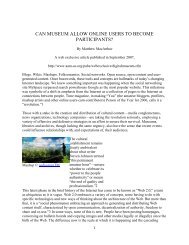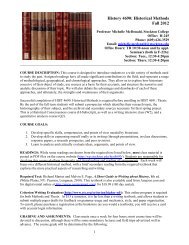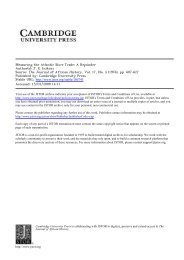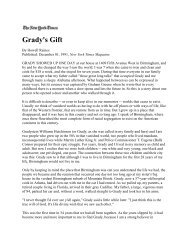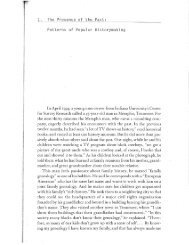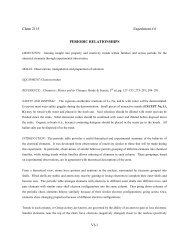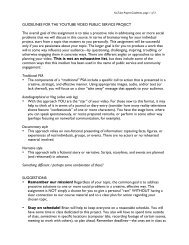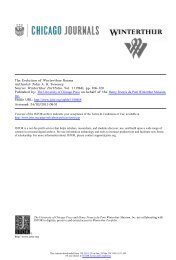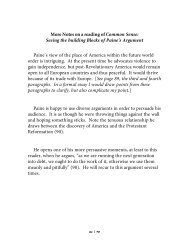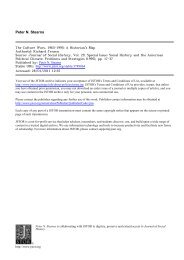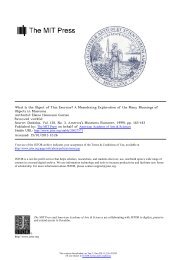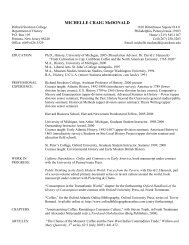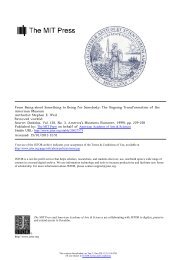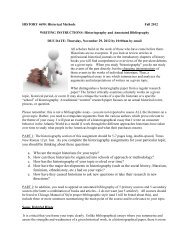Domesticating Barbie - Richard Stockton College Word Press ...
Domesticating Barbie - Richard Stockton College Word Press ...
Domesticating Barbie - Richard Stockton College Word Press ...
You also want an ePaper? Increase the reach of your titles
YUMPU automatically turns print PDFs into web optimized ePapers that Google loves.
256 Pearson and Mullins<br />
BARBIE AS A DISTORTED REFLECTION<br />
It is often argued that <strong>Barbie</strong> is simply a reflection of her times, a mirror<br />
of fashion, women's roles, body image, and material consumption. <strong>Barbie</strong> ma<br />
terial culture certainly does not<br />
ignore dominant social currents, but <strong>Barbie</strong>'s<br />
"reflections" represent only select possibilities at various historical moments. What<br />
<strong>Barbie</strong> reflects is a complicated tangle of dominant ideologies and resistant sym<br />
bolism: if <strong>Barbie</strong> is a mirror of society, it is at best a distorted and prepossessed<br />
reflection.<br />
Well before 1963, when Betty Friedan (1983) defined "the problem that has<br />
no name," a significant number of women were defying the Feminine Mystique<br />
and forging a place for themselves in the male-dominated workforce. <strong>Barbie</strong> was<br />
created in the image of these women, the Charlotte Johnsons and Ruth Handlers of<br />
the world, whose aspirations and agency basically went unspoken. Consequently,<br />
the doll had potentially revolutionary implications from the outset by even tacitly<br />
acknowledging women's agency and power in a wide range of settings.<br />
According to Mattel, <strong>Barbie</strong>'s persona and age deliberately were left vague so<br />
that children could play with her according to their own imaginations, rather than<br />
a preset <strong>Barbie</strong> personality. To facilitate flexible play, Mattel marketed a varied<br />
wardrobe appropriate to settings ranging from very casual to very elegant. But<br />
<strong>Barbie</strong> never was designed to be a cipher that could accommodate a vast range of<br />
social possibilities or experiences. <strong>Barbie</strong> was a structured representation, a career<br />
woman whose every box proclaimed her status as 'Teen-age Fashion Model"<br />
and implicitly bespoke her class standing. Her sophisticated, high-fashion outfits<br />
were things <strong>Barbie</strong> modeled as part of her job and not "real life," but there were<br />
no "Factory Shift" ensembles suggesting a lower-class lifestyle, and the college<br />
educated <strong>Barbie</strong> spent her vacation time at resorts and on cruises. Consumers who<br />
wished to defy such symbolism could make their own <strong>Barbie</strong> clothing, limited only<br />
by their imagination and sewing skills, or they could purchase patterns (Caviale,<br />
1997; Cross, 1996). Patterns certainly were less costly than the prefabricated fash<br />
ions: in 1962, for instance, Mattel-licensed patterns retailed in the Ward's catalog<br />
for 98tf for a package of 12 {<strong>Barbie</strong> Bazaar, 1994, p. 68). This contrasted with the<br />
price of premade fashions, which ranged from $1.29 to $2.64 each in the same<br />
catalog (<strong>Barbie</strong> Bazaar, 1994, p. 69). These licensed patterns, though, represented<br />
the same activities as the fashion ensembles. Certainly an imaginative child could<br />
place a well-dressed <strong>Barbie</strong> in virtually any sort of play situation, and an enter<br />
prising parental seamstress could produce outfits that encouraged nontraditional<br />
roles, but neither the patterns nor the fashions stimulated such resistance.<br />
<strong>Barbie</strong>'s early career options reflected historicized gender expectations, be<br />
cause most of her activities were coded as female occupations about which a young<br />
girl might dream (e.g., model, registered nurse, ballerina, stewardess, nightclub<br />
singer). Yet, while in explicitly gendered female careers, <strong>Barbie</strong> was nonetheless<br />
working at a time when few American women were employed<br />
This content downloaded on Tue, 15 Jan 2013 10:45:42 AM<br />
All use subject to JSTOR Terms and Conditions<br />
outside the home.



